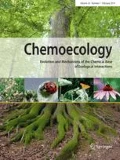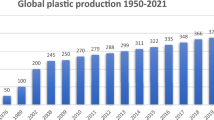Abstract
The influence of 63 dietary allelochemicals (alkaloids, terpenes, glycosides,etc.) on the feeding behaviour of bees (Apis mellifera) was tested in terms of deterrency and attraction. For 39 compounds a deterrent (mostly alkaloids, coumarins and saponins) and for 3 compounds an attractive response (mostly terpenes) was obtained in choice tests, which allowed the calculation of respective ED50-values. Under no-choice conditions, 17 out of 29 allelochemicals caused mortality at concentrations between 0.003 and 0.6%. Especially toxic were alkaloids, saponins, cardiac glycosides and cyanogenic glycosides. These data show that bees which are confronted with plant allelochemicals in nectar and pollen, are not especially adapted (i.e. insensitive) to the plants' defence chemistry. GLC and GLS-MS data are given on the alkaloid composition of nectar and pollen ofBrugmansia aurea, Atropa belladonna andLupinus polyphyllus.
Similar content being viewed by others
References
Adams CM, Bernays EA (1978) The effect of combinations of deterrents on feeding behaviour ofLocusta migratoria. Entomol exp appl 23:101–109
Amiot MI, Aubert S, Gonnet M, Tacchini M (1989) Les composes phenolique des miels: etude preliminaire sur l'identification et la quantification par familles. Apidologie 20:115–125
Baker HG (1977) Non-sugar chemical constituents of nectar. Apidologie 8:349–356
Baker HG, Baker I (1975) Studies on nectar constitution and pollinator-plant coevolution. Pp 100–140in Gilbert LE, Raven PH (eds) Coevolution of Animals and Plants. Austin: Univ of Texas Press
Barragan de Dominguez MC (1973) Contribucion al estudio de mieles toxicas colombianas. Rev Colomb Cienc Quim-Farm 2:5–31
Bentley MD, Leonard DE, Reynolds EK, Leach S, Beck AB, Murakoshi I (1984) Lupine alkaloids as larval feeding deterrents for spruce budworm,Choristoneur a fumiferana (Lepidoptera: Tortricidae). Ann Entomol Soc Am 77:398–400
Bernays EA, Graham M (1988) On the evolution of host specificity in phytophagous arthropods. Ecology 69:886–892
Bernays EA, Chapman R (1987) The evolution of deterrent responses in plant-feeding insects. Pp 159–173in Bernays E, Chapman M, Stoffolano J (eds) Perspectives in Chemoreception and Behaviour. New York, Heidelberg: Springer Verlag
Bestmann HJ Claßen B, Kobold U, Vostrowsky O, Klingauf F, Stobel H, Knobloch K (1984) Pflanzliche Insektizide II. Das ätherische Öl aus Blättern des Balsamkrautes,Chysanthemum balsamita L. Insektizide Wirkung und Zusammensetzung. Z Naturforsch 39c:543–547
Blades D, Mitchell BK (1986) Effects of alkaloids on feeding byPhormia regina. Entomol exp appl 41:299–304
Borg-Karlson A (1990) Chemical and ethological studies of pollination in the genusOphrys (Orchidaceae). Phytochemistry 29:1359–1387
Cavin JC, Rodrigues E (1988) The influence of dietaryβ-carboline alkaloids on growth rates, food consumption and food utilisation of larvae ofSpodoptera exigua. J Chem Ecol 14:475–484
Christen P, Roberts MF, Phillipson JD, Evans WC (1990) Alkaloids of hairy root cultures of aBrugmansia candida hybrid. Plant Cell Reports 9:101–104
Clinch PG, Palmer-Jones T, Forster IW (1972). Effect on honeybees of nectar from the yelllow kowhai (Sophora microphylla Ait.). NZ J Agric Res 15:194–201
Culvenor CCJ, Edgar JA, Smith LW (1981) Pyrrolizidine alkaloids in honey fromEchium plantagineum. J Agric Food Chem 29:958–960
D'Arcy WG, D'Arcy NS, Keating RC (1990) Scented anthers in the Solanaceae. Rhodora 92:50–53
Deinzer ML, Thompson PA (1977) Pyrrolizidine alkaloids: Their occurrence in honey from tansy ragworth (Senecio jacobaea L.). Science 195:497–499
Dethier VG, Bowdan E (1989) The effect of allelochemicals on sugar receptors and feeding behaviour of the bowfly. Physiol Entomol 14:127–136
Detzel A (1990) Untersuchungen zum Einfluß pflanzlicher Sekundärstoffe auf phytophage insekten am Beispiel vonSyntomeida epilais (Ctenuchidae, Lepidoptera) undApis mellifera (Apidae, Hymenoptera). Master Thesis, Univ. Mainz
Devitt BF, Philogene BJR, Kinks CF (1980) Effects of veratrine, berberine, nicotine and atropine on developmental characteristics and survival of the dark-sided cutworm,Euxoa messaria. Phytoprotection 61:88–102
Dobson JEM 1988: Survey of pollen and pollenkitt lipids — chemical cues to flower visitors? Amer J Bot 75:170–182
Dobson JEM, Bergström J, Bergström G, Groth I (1987) Pollen and flower volatiles in twoRosa species. Phytochemistry 26:3171–3173
Free JB (1963) The flower constancy of honeybees. J Anim Ecol 32:119–131
Frisch K von (1914) Der Farbensinn und Formensinn der Bienen. Zool J (Physiol) 35:1–188
Frisch K von (1934) Über den Geschmacksinn der Biene. Z vergl Phys 21:2–154
Gill JS (1972) Studies on insect feeding deterrents with special reference to the fruit extracts of the neem tree. PHD thesis, University of London
Harborne JB (1988) Introduction to Ecological Biochemistry. London, New York: Academic Press
Holzinger F, Frick C, Wink M (1992) Molecular base for the insensitivity of the monarch (Danaus plexippus) to cardiac glycosides. FEBS Lett 314:477–480
Janzen D, Inster HB, Bell EA (1987) The toxicity of secondary compounds to the seed eating larvae of the bruchid beetle,Callosobruchus maculatus. Phytochemistry 16:223–227
Kolterman R (1969) Lern- und Vergessensprozesse bei der Honigbiene — aufgezeigt anhand von Duftdressuren. Z Physiol 63:310–334
Larson RA, Marley KA, Tuveson RW, Berenbaum MR (1988) Carboline alkaloids mechanisms of phototoxicity to bacteria and insects. Photochem & Photobiol 48:665–674
Lüttge U (1977) Nectar composition and membrane transport of sugars and amino acids: a review on the present state of nectar research. Apidologie 8:305–319
Masters AR (1991) Dual role of pyrrolizidine alkaloids in nectar. J Chem Ecol 17:195–205
Mauricio A, Grafl J 1969. Das Trachtpflanzenbuch. München: Ehrenwirth-Verlag
Maurizio A (1945) Giftige Bienenpflanzen. Beihefte zur SBL 1:430–441
Menzel R, Erber J, Masuhr T (1974) Learning and memory in the honeybee. Pp 195–217in Barton-Brown L (ed.) Experimental Analysis of Insect Behaviour. New York: Springer Verlag
Miles DH, Ly AM, Randle SA, Hedin PA, Burks MLJ (1987) Alkaloid insect antifeedants fromVirola calophylla. Agric Food Chem 35:794–797
Nathanson J (1984) Caffeine and related methylxanthines: possible natural pesticides. Science 226:184–187
Ribbands CR (1949) The foraging method of individual honeybees. J Anim Ecol 18:47–66
Rosenthal GA, Janzen DH (eds) (1979) Herbivores. Their Interaction with Secondary Plant Metabolites. London, New York: Academic Press
Stephenson AG (1982) Iridoid glycosides in the nectar ofCatalpa speciosa are unpalatable to nectar thieves. J Chem Ecol 8:1025–1034
Schulz-Langner E (1967) Über den Trachtwert der Rosskastanie (Aesculus hippocastanum) unter besonderer Berücksichtigung des Saponingehaltes im Nektar. Z Bienenforsch 9:49–65
Scogin R (1979) Nectar constituents in the genusFremontia (Sterculiaceae): sugars, flavonoids, and proteins. Bot Gaz 140:29–31
Shaver T, Lukefahr MJ (1969) Effects of flavonoid pigments and gossypol on growth and development of bollworm, tobacco budworm und pink bollworm. J Econ Entomol 62:643–646
Spector M, O'Neal S, Racker E (1980) Reconstitution of Na+/K+ pump of Ehrlich ascites tumour and enhancement of effects by quercetin. J Biol Chem 255:5504–5507
Stephenson AG (1982) Iridoid glycosides in the nectar ofCatalpa speclosa are unpalatable for nectar thieves. J Chem Ecol 8:1025–1034
Sosath S (1984) Honige von Euphorbiaceen als Nahrungs- und Genussmittel. Dissertation at the DKFZ, Heidelberg, Germany
Stanley RG, Linskens HF (1985) Pollen. D-Greifenberg: Urs Freund Verlag
Thiery D, Bluet, JM, Pham-Delegue M, Etievant P, Masson C (1990) Sunflower aroma detection by the honeybee. J Chem Ecol 16:701–711
Towers GHN (1986) Significance of phototoxic phytochemicals in insect herbivores. J Chem Ecol 12:813–821
Vogel S (1977) Nektarien und ihre ökologische Bedeutung. Apidologie 8:321–335
Wagner H (1988) Pharmazeutische Biologie. Stuttgart-New York: Gustav Fischer Verlag
Wells H, Wells PH (1983) Honeybee foraging ecology: optimal diet, minimal uncertainty or individual constancy? J Anim Ecol 52:829–836
Wink M (1988) Plant breeding: importance of plant secondary metabolites for protection against pathogens and herbivores. Theor Appl Genet 75:225–233
Wink M, Schneider D (1990) Fate of plant-derived secondary metabolites in three moth species (Syntomis mogadorensis, Syntomeida epilais andCreatonotos transiens). J Comp Physiol B 160:389–400
Wink M (1992) Roles of quinolizidine alkaloids in plant-insect interactions. Focus on insect-plant interactions. Pp 133–169in Bernays EA (ed.) Insect-Plant Interactions, Vol IV. Boca Raton, FL: CRC Press
Wink M (1993a) Allelochemical properties or the raison d'etre of Alkaloids. Pp. 1–118in Cordell J (ed.) The Alkaloids, Vol 43. New York: Academic Press
Wink M (1993b) Quinolizidine alkaloids. Pp 197–239in Waterman P (ed.) Methods in Plant Biochemistry, Vol 8, Alkaloids and Sulfur Compounds. New York: Academic Press
Wink M, Witte L (1991) Storage of quinolizidine alkaloids inMacrosiphon albifrons andAphis genistae (Homoptera: Aphididae). Entomol Gener 15:237–254
Wink M, Schiebel JM, Witte L, Hartmann T (1982) Quinolizidine alkaloids from plants and their cell suspension cultures. Planta Medica 44:15–20
Wink M, Witte L, Hartmann T, Theuring C, Volz V (1983) Accumulations of quinolizidine alkaloids in plants and cell suspension cultures: generaLupinus, Cytisus, Baptisia, Genista, Laburnum, andSophora. Planta Medica 48:253–257
Witte L, Müller K, Arfmann H (1987) Investigation of the alkaloid pattern ofBrugmansia innoxia plants by GLC-MS. Planta Medica 53:192–197
Zuniga GE, Corcuera LJ (1986) Effect of gramine on the resistance of barley seedlings to the aphidPhopalosiphon padi. Entomol exp appl 40:259–262
Zuniga GE, Varanda EM, Corcuera LJ (1988) Effect of gramine on the feeding behaviour of the aphidSchizaphis graminum. Entomol exp appl 47:161–165
Author information
Authors and Affiliations
Rights and permissions
About this article
Cite this article
Detzel, A., Wink, M. Attraction, deterrence or intoxication of bees (Apis mellifera) by plant allelochemicals. Chemoecology 4, 8–18 (1993). https://doi.org/10.1007/BF01245891
Issue Date:
DOI: https://doi.org/10.1007/BF01245891




